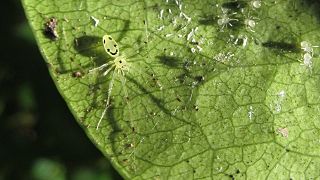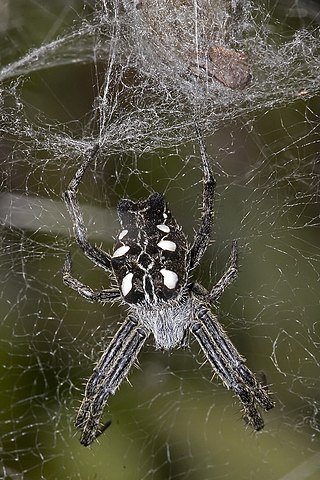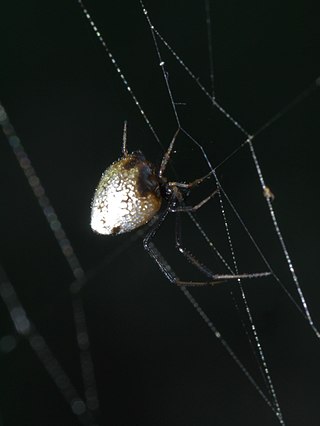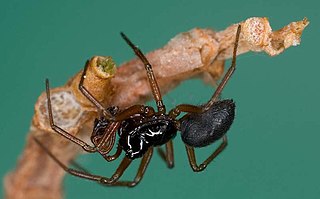
The katipō is an endangered species of spider native to New Zealand. It is one of many species in the genus Latrodectus, such as the Australian redback, and the North American black widow. The species is venomous to humans, capable of delivering a potentially dangerous bite. It is a small to medium-sized spider, with the female having a round black or brown pea-sized body. Red katipō females found in the South Island and the lower half of the North Island, are always black, and their abdomen has a distinctive red stripe bordered in white. In black katipō females found in the upper half of the North Island, this stripe is absent, pale, yellow, or replaced with cream-coloured blotches. These two forms were previously thought to be separate species. The male is much smaller than the female and quite different in appearance: white with black stripes and red diamond-shaped markings. Katipō are mainly found living in sand dunes close to the seashore. They are found throughout most of coastal New Zealand except the far south and west. Katipō feed mainly on ground dwelling insects, caught in an irregular tangled web spun amongst dune plants or other debris.

Nephila is a genus of araneomorph spiders noted for the impressive webs they weave. Nephila consists of numerous species found in warmer regions around the world, although some species formerly included in the genus have been moved to Trichonephila. They are commonly called golden silk orb-weavers, golden orb-weavers, giant wood spiders, or banana spiders.

Steatoda nobilis is a spider in the genus Steatoda, known in the United Kingdom as the noble false widow, as it superficially resembles and is frequently mistaken for the black widow and other spiders in the genus Latrodectus. It is often referred to as thefalse widow, although "false widow" is a more general term applied to a wider group of species with this resemblance. It is a moderately medically significant spider, with most bites resulting in symptoms similar to a bee or wasp sting. Some bites may cause more significant harm, partly due to pathogenic bacteria from the spiders.

Phidippus audax, the bold jumper or bold jumping spider, is a common species of spider belonging to the genus Phidippus, a group of jumping spiders easily identified by their large eyes and their iridescent chelicerae. Like all jumping spiders, they have excellent stereoscopic vision that aids them in stalking prey and facilitates visual communication with potential mates during courting. Bold jumping spiders are native to North America and have been introduced to Hawaii, Nicobar Islands, Azores, and the Netherlands. They are typically black with a distinct white triangle on their abdomen.

Theridion grallator, also known as the Hawaiian happy-face spider, is a spider in the family Theridiidae that resides on the Hawaiian Islands. T. grallator gets its vernacular name of "Hawaiian happy-face spider" from the unique patterns superimposed on its abdomen, specifically those that resemble a human smiling face. T. grallator is particularly notable because of its wide range of polymorphisms that may be studied to allow a better understanding of evolutionary mechanisms. In addition to the variety of color polymorphisms present, T. grallator demonstrates the interesting quality of diet-induced color change, in which its appearance temporarily changes as it metabolizes various food items.

Zygiella x-notata, sometimes known as the missing sector orb weaver or the silver-sided sector spider, is a spider species in the family Araneidae. They are solitary spiders, residing in daily-spun orb webs. Z. x-notata is a member of the genus Zygiella, the orb-weaving spiders. The adult female is easily recognized by the characteristic leaf-like mark on her posterior opisthosoma, caudal to the yellow-brown cephalothorax.
Spider behavior refers to the range of behaviors and activities performed by spiders. Spiders are air-breathing arthropods that have eight legs and chelicerae with fangs that inject venom. They are the largest order of arachnids and rank seventh in total species diversity among all other groups of organisms which is reflected in their large diversity of behavior.
A social spider is a spider species whose individuals form relatively long-lasting aggregations. Whereas most spiders are solitary and even aggressive toward other members of their own species, some hundreds of species in several families show a tendency to live in groups, often referred to as colonies.

Cyrtophora citricola, also known as the tropical tent-web spider, is an orb-weaver spider in the family Araneidae. It is found in Asia, Africa, Australia, Costa Rica, Hispaniola, Colombia, and Southern Europe and in 2000, it was discovered in Florida. C. citricola differs from many of its close relatives due its ability to live in a wide variety of environments. In North America and South America, the spider has caused extensive damage to agricultural operations.

Anelosimus eximius is a species of social spider in the genus Anelosimus, native to the Lesser Antilles and the area from Panama to Argentina. Colonies can comprise several thousand individuals.

Rugathodes sexpunctatus is a minute species of spider in the family Theridiidae, the cobweb or tangle-web spiders. This family includes the medically important genus Latrodectus—the widow spiders. The species in the genus Rugathodes are too small to be dangerous to humans. Very little is known about most species in this genus.

Spiders are air-breathing arthropods that have eight legs, chelicerae with fangs generally able to inject venom, and spinnerets that extrude silk. They are the largest order of arachnids and rank seventh in total species diversity among all orders of organisms. Spiders are found worldwide on every continent except for Antarctica, and have become established in nearly every land habitat. As of November 2023, 51,673 spider species in 136 families have been recorded by taxonomists. However, there has been debate among scientists about how families should be classified, with over 20 different classifications proposed since 1900.
Stegodyphus sarasinorum, also known as the Indian cooperative spider, is a species of velvet spider of the family Eresidae. It is native to India, Sri Lanka, Nepal, and Myanmar. This spider is a social spider that exhibits communal predation and feeding, where individuals live in large cooperatively built colonies with a nest or retreat constructed of silk woven using leaves, twigs, and food carcasses, and a sheet web for prey capture.

Argyrodes elevatus, commonly referred to as dew-drop spider, is part of the family Theridiidae that consists of more than 3,000 species. These spiders are most commonly found in subtropical and tropical regions in South and Central America, as well as southern regions of the United States. One of the key distinguishing characteristics of A. elevatus is its kleptoparasitic behavior through which it primarily procures food for survival. Typically 1 or 2 A. elevatus spiders preside in outer areas of webs built by other species of spiders, although it is possible for up to 45 spiders. There are two main mechanisms by which A. elevatus raid the hub of the host's web to steal insects preyed and wrapped by the host spider. A. elevatus follows an intricate course to the hub of the web to search for prey, using vibrational detection enhanced by laid out threads along the web to find and capture the insect. These spiders are highly efficient, with the theft lasting a maximum of 12 seconds and high success rates. This reliance on a host spider for food has led to adaptations in sleep schedules and alternate food sources to revolve around the host species activity. A. elevatus display a unique courtship routine in which male A. elevatus presents prey wrapped in silk as a nuptial gift to the female spider. The male spider approaches the female, carrying the nuptial gift on its chelicerae while communicating with a distinct courting vibration, followed by copulation. Approximately twenty-four hours after the A. elevatus courtship and copulation series of events, the female spider will lay one to two eggs on the outer regions of the host's web.

Erigone atra is a species of dwarf spider or money spider, in the family Linyphiidae. It is commonly found in North America, Europe, parts of Russia, Central Asia, China, Mongolia, Korea, and Japan. This spider is one of the most common Erigone spiders. E. atra is an important spider for agriculture, as it preys on pests such as aphids which are commonly found on crops. E. atra spiders are aeronautical spiders, as they travel via ballooning. This technique, sometimes referred to as kiting, allows E. atra spiders to traverse large distances and find new habitats when environmental or human stresses create unfit living environments. E. atra is difficult to differentiate from other congeneric species because of their similar sizes and coloring.
Philoponella oweni is a species of spider belonging to the family Uloboridae, the cribellate orb weavers. They are around 4.7–7.1 mm long in length and are primarily found in the arid southwestern parts of the United States. These spiders are most known for being semi-social, a rare trait within spiders. Semi-social, in the case of P. oweni, refers to the coexistence of facultatively communal and solitary females within the same habitat. These groups usually form in response to environmental factors, and often never involve true cooperation. This lack of true cooperation means these spiders do not share prey items, do not work together when spinning webs and do not care for one another's young. The coexistence of both solitary and communal species within the same habitat can be explained by both tactics have similar net reproductive success values. This was can be explained by comparing the number of eggs within egg cases to the number of surviving offspring for both tactics. The number of surviving offspring of communal and solitary beings does not vary significantly, which mostly due to the parasitism by pteromalid wasps. These wasp which prefer consume and parasitize communal P. oweni webs and eggs, counteracting the increase of eggs per egg case that communal spiders tend to produce over solitary.

Mastophora hutchinsoni, also known as the American bolas spider, is a species of orb weaver in the genus Mastophora. The genus is distributed extensively throughout various subtropical geographical areas including Australia, South Africa, Oriental Asia, and the Americas and is not found in Europe. The hunting behavior of adult female M. hutchinsoni is unusual because they are bolas spiders. They mimic moth pheromones to attract male moths, and female M. hutchinsoni have evolved to alter their chemical release to target different moths. They then capture their prey with a sticky drop on the end of a silk line, resembling a bolas.

Stegodyphus dumicola, commonly known as the African social spider, is a species of spider of the family Eresidae, or the velvet spider family. It is native to Central and southern Africa. This spider is one of three Stegodyphus spiders that lives a social lifestyle. This spider has been studied living in large natal colonies in large, unkempt webs. Each colony is composed mainly of females, where a minority act as reproducers, and a majority remain childless and take care of the young. Males live a shorter lifespan, during which they will largely remain in the natal nest. Females are known for extreme allomaternal care, since all females – even unmated virgin ones – will take care of the young until they are eventually consumed by the brood.

Pardosa agrestis is a non-web-building spider in the family Lycosidae, commonly known as wolf spiders.

Pardosa pseudoannulata, a member of a group of species referred to as wolf-spiders, is a non-web-building spider belonging to the family Lycosidae. P. pseudoannulata are wandering spiders that track and ambush prey and display sexual cannibalism. They are commonly encountered in farmlands across China and other East Asian countries. Their venom has properties that helps it function as an effective insecticide, and it is, therefore, a crucial pesticide control agent.















